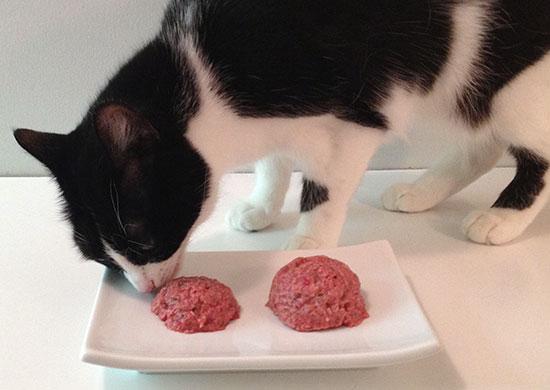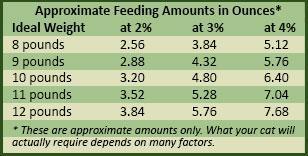This content is archived from the Feline Nutrition Foundation
Answers: Making Raw Cat Food Kitty-Sized
- Updated: Tuesday, May 28, 2019 03:45 PM
- Published: Saturday, June 14, 2014 07:34 PM
- Written by Margaret Gates
 I just transitioned my kitty from dry food to a raw cat food diet. Since she is now fed meals instead of just eating whatever she wants out of the never-ending bowl of kibble, I realize I don't know how much food to give her! Help!
I just transitioned my kitty from dry food to a raw cat food diet. Since she is now fed meals instead of just eating whatever she wants out of the never-ending bowl of kibble, I realize I don't know how much food to give her! Help!
We get this question a lot. There is no set amount, but there are basic guidelines as to how much to feed. How much food your cat needs is going to depend on a lot of things: age, activity level, general health, genetics and the actual composition of the food. The amounts we outline are for adult cats over one year old. Young cats and kittens will need more than this. Kittens can require twice the amount of food per pound of body weight as an adult, because they are still growing, not just maintaining. Also, pregnant and nursing cats will require more than these amounts.
As you have just transitioned her to a healthy raw cat food diet, it will take a little time to find out how much to feed her. The first thing you absolutely must have is an accurate scale to weigh your cat. The second is an accurate kitchen scale to weigh the food. You need to get a starting weight for your cat so you can tell if she is gaining or losing weight on the amount you feed. You don't want to wait until you can tell just by looking, and besides, with fluffy cats it can be difficult to see. If you don't have a baby scale, then weigh yourself holding her on a good bathroom scale, then weigh yourself alone and subtract the difference. Take notes!
The general rule of thumb for the amount to feed adult cats, either in raw or canned food, is to feed 2 to 4% of the cat's ideal body weight per day. For an inactive and/or older cat, the 2% amount might be good and for a very active and/or younger cat, 4% might be closer to what's needed. Start in the middle at 3% and then see how she does. This is why accurate weigh-ins are critical. You'll notice that you should start with your cat's ideal weight. Since most cats are overweight, you may have to guess at this or ask your vet. Using an amount based on an ideal weight will yield a feeding amount that will get her down to that weight slowly. Or, up to that weight if she's underweight.
 For example, using the middle percentage of 3% and an ideal weight of nine pounds, a cat would need about 4.3 ounces of food a day:
For example, using the middle percentage of 3% and an ideal weight of nine pounds, a cat would need about 4.3 ounces of food a day:
9 x 16 = 144 x .03 = 4.32
Nine pounds x 16 equals 144 ounces, times 3 percent is 4.32 ounces.
We've put together a table that will give you an idea of the range. You should weigh your cat every few days in the beginning to see if her weight is fluctuating. After a few weeks, you should have a good idea of about how much raw cat food to feed per day. It's still a good idea to weigh her every week or so and keep a log, to make sure the amount you feed is still right. This is especially important if you are trying to get your cat's weight down. You want to see a slow, but consistent, weight drop. Watch out for sudden drops in weight, as that could indicate illness.
Additional Reading
Tips for Transitioning Your Finicky Kitties
Note: Feline Nutrition provides feline health and nutrition information as a public service. Diagnosis and treatment of specific conditions should always be in consultation with your own veterinarian. Feline Nutrition disclaims all warranties and liability related to the veterinary advice and information provided on this site.
Margaret Gates is the founder of the Feline Nutrition Foundation.




